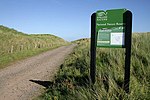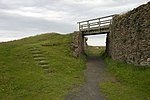Holy Island War Memorial
1922 sculpturesGrade II* listed buildings in NorthumberlandGrade II* listed monuments and memorialsLindisfarneMonuments and memorials in Northumberland ... and 4 more
War memorials by Edwin LutyensWorks of Edwin Lutyens in EnglandWorld War II memorials in EnglandWorld War I memorials in England

Holy Island War Memorial, or Lindisfarne War Memorial, is a First World War memorial on the tidal island of Lindisfarne (or Holy Island) off the coast of Northumberland in the far north east of England. Designed by Sir Edwin Lutyens, the memorial is a grade II* listed building.
Excerpt from the Wikipedia article Holy Island War Memorial (License: CC BY-SA 3.0, Authors, Images).Holy Island War Memorial
Church Lane,
Geographical coordinates (GPS) Address External links Nearby Places Show on map
Geographical coordinates (GPS)
| Latitude | Longitude |
|---|---|
| N 55.66827 ° | E -1.80065 ° |
Address
Cenotaph
Church Lane
TD15 2RX , Holy Island
England, United Kingdom
Open on Google Maps









